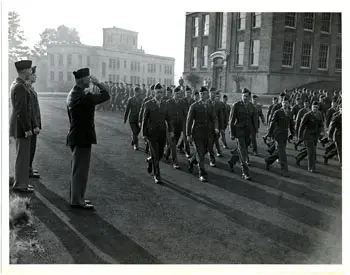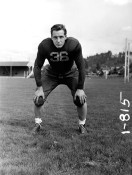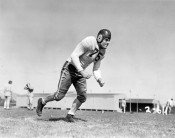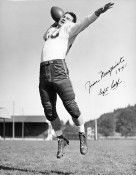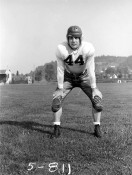www.ohsu.edu
Oregon’s 1942 football season had turned out to be a major disappointment, finishing 2-6 with a roster that had managed to beat the eventual Rose Bowl bound 7-4 UCLA Bruins. To make matters worse, even though the Pacific Coast Conference (PCC) had voted to allow freshman eligibility in December 1942, it would not be enough to save varsity football at Oregon for the 1943 and 1944 football seasons. The Ducks certainly planned on fielding a team in 1943, but events beyond their control would eventually force cancellation of both the 1943 and 1944 seasons.
America’s military services had supported the continuation of varsity sports in 1942, and the Navy and Marines would continue to do so through their on-campus programs, such as the Navy V-12 program. Unfortunately, the Army would take a different approach, which directly impacted the direction of the Ducks football program.
Despite the losses from the 1942 team by graduation and military service, Oregon opened spring practice in March 1943 with a turnout of 80 players, although only 33 of those players were varsity candidates. From this group of 33, there were nine returning lettermen, such as Chuck Elliott, Cliff Giffin and Bill Mayther. At Oregon many college athletes were enrolled in the Army’s Enlisted Reserve Corps program, which included many of the Ducks letter winners. Several of these players, including Bud Cote, Ray Blatchley, George Dugan, Bobby Reynolds and John Garrison had been called to active duty prior to spring practice.
In August 1943, the Army declared that college students enrolled in the Enlisted Reserve Corps program could not participate in varsity sports. This decision left many schools with few experienced players, forcing reliance on freshmen and those determined to not be physically capable of military service (4-F). As a result, schools started dropping their football programs for the 1943 season, including Montana and Stanford of the PCC. Most of the PCC schools in the Northwest continued preparation for the ’43 season despite delaying the opening of fall practice until mid-September.
However, those teams quickly realized they would not be able to field competitive teams that year. Oregon took the lead by calling a meeting of the Athletic Directors for the PCC’s Northwest members to decide how to proceed. Oregon, facing ineligibility of so many experienced players, was the first school to drop its varsity football program. The Ducks were quickly followed by Oregon State, Washington State and Idaho. Washington decided to continue with its varsity football program, having the luxury of a Navy V-12 program which provided all of its players. Whitman and Willamette were the only other Northwest schools with a V-12 program. One additional advantage of having a V-12 program is that playing in such a program would not count against a player’s future college eligibility.
The decision to drop its varsity football team did not mean that football was completely gone from the campus. Oregon quickly announced that it would institute intramural football, with John Warren heading the program. The program would include 1,000 students with a “representative” team that would play exhibition games against service training schools, army camps and naval bases in the area. The team was unofficially known as the Army Ducks and included several players who had some college playing experience, although none had played in the PCC. Willamette, with its V-12 team (Navycats), would be Oregon’s first opponent. Predictably, the Army Ducks lost to Willamette, which featured former Oregon frosh players Bob Sheridan, Gerald Wolfsher and Jim Porter. Over time, the Army Ducks managed to have success against some of the military teams from bases at Marshfield and White City.
As World War II began to reach its conclusion in 1945, Oregon and its fellow Northwest schools decided to field varsity football teams for the 1945 season. By this time, Tex Oliver, with the coaches and trainer he had taken with him in 1942, had returned to Eugene and began preparing for the 1945 season. The team the Ducks fielded would be very inexperienced – there were no seniors, only three juniors, a handful of sophomores, with the bulk of the team made up of freshmen. Bobby Reynolds from the 1942 team was the only returning letterman. There were three players who had been in Oregon’s 1943 fall practices on this 1945 team: Gil Roberts, Don Taylor and Dale Hargett. Fortunately, Jake Leicht, who would become Oregon’s first post-World War II star, joined the team shortly before the season after having played for the Fourth Air Force football squad. The 1945 season would result in a 3-6 record for the Ducks.
It would be the 1946 season that would see the return of more Ducks from military service. The migration of returning Ducks veterans came from multiple years: from the 1942 team included Chuck Elliott, Cliff Giffin and Pete Torchia; from the 1941 team came Tony Crish, Duke Iverson, Bob Koch and Jim Newquist; from the 1942 freshman team were Benny Holcomb and Don Stanton; and finally, Brad Ecklund, from the 1941 frosh team returned from the Marines, having previously flunked out of school before the war.
Most of these players had continued to play for various service teams during the war, and two – Holcomb and Giffin – had played for other colleges in 1943 – Holcomb with Whitman College, and Giffin with the hated Huskies. Unfortunately, even with this infusion of talent, several of whom would go on to play professionally, it would not be enough to save Tex Oliver’s job. Oregon would start out the 1946 season with three consecutive victories, but the remainder of the season would not go so well. Following a 0-0 tie with Washington State and a victory over Idaho, the Ducks lost their last four games of the season — failing to score a single point in any game. That was the end of Oliver’s coaching career at Oregon.
The 1947 season would see a reversal of fortune under new coach Jim Aiken, with the Ducks going 7-3 led by many of the players who had returned in 1946, as well as Leicht, who had returned in 1945. Ecklund, Holcomb and Stanton would continue on as major contributors to the 1948 Cotton Bowl team that finished a respectable 9-2.
Related Articles:
Jim currently resides in Ellensburg, Washington where he has had the opportunity to watch former Ducks such as NaDerris Ward and Scott Grady play for Central Washington University, Jim’s alma mater. However, Jim was born in Eugene and attended Howard Elementary School, and what then called Colin Kelly Junior High School before moving to Washington. Jim began following the Ducks during the 1957 season and had the opportunity to watch a number of games at Hayward Field. Over the years, Jim has developed a wealth of knowledge about Oregon sports history. When not editing on Fanbase.com or working in his garden, Jim manages to find time to practice law.

